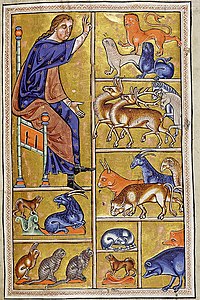Bestiary




A bestiary, or Bestiarum vocabulum is a compendium of beasts. Bestiaries were made popular in the Middle Ages in illustrated volumes that described various animals, birds and even rocks. The natural history and illustration of each beast was usually accompanied by a moral lesson. This reflected the belief that the world itself was the Word of God, and that every living thing had its own special meaning. For example, the pelican, which was believed to tear open its breast to bring its young to life with its own blood, was a living representation of Jesus. The bestiary, then, is also a reference to the symbolic language of animals in Western Christian art and literature.
The Middle Ages
Bestiaries were particularly popular in England and France around the 12th century and were mainly compilations of earlier texts. The earliest bestiary in the form in which it was later popularized was an anonymous 2nd century Greek volume called the Physiologus, which itself summarized ancient knowledge and wisdom about animals in the writings of classical authors such as Aristotle's Historia Animalium and various works by Herodotus, Pliny the Elder, Solinus, Aelian and other naturalists.
Following the Physiologus, Saint Isidore of Seville (Book XII of the Etymologiae) and Saint Ambrose expanded the religious message with reference to passages from the Bible and the Septuagint. They and other authors freely expanded or modified pre-existing models, constantly refining the moral content without interest or access to much more detail regarding the factual content. Nevertheless, the often fanciful accounts of these beasts were widely read and generally believed to be true. A few observations found in bestiaries, such as the migration of birds, were discounted by the natural philosophers of later centuries, only to be rediscovered in the modern scientific era.
Two illuminated Psalters, the Queen Mary Psalter (British Library Ms. Royal 2B, vii) and the Isabella Psalter (State Library, Munich), contain full Bestiary cycles. The bestiary in the Queen Mary Psalter is found in the "marginal" decorations that occupy about the bottom quarter of the page, and are unusually extensive and coherent in this work. In fact the bestiary has been expanded beyond the source in the Norman bestiary of Guillaume le Clerc to ninety animals. Some are placed in the text to make correspondences with the psalm they are illustrating.[1]
The Italian artist Leonardo da Vinci also made his own bestiary.[2]
The Aberdeen Bestiary is one of the best known of over 50 manuscript bestiaries surviving today.
Mediaeval bestiaries are remarkably similar in sequence of the animals of which they treat.
Modern Bestiaries
In modern times, artists such as Henri de Toulouse-Lautrec and Saul Steinberg have produced their own bestiaries. Jorge Luis Borges wrote a contemporary bestiary of sorts, the Book of Imaginary Beings, which collects imaginary beasts from bestiaries and fiction. Nicholas Christopher wrote a literary novel called "The Bestiary" (Dial, 2007) that describes a lonely young man's efforts to track down the world's most complete bestiary. John Henry Fleming's Fearsome Creatures of Florida[3] (Pocol Press, 2009) borrows from the medieval bestiary tradition to impart moral lessons about the environment. Writers of Fantasy fiction draw heavily from the fanciful beasts described in mythology, fairy tales, and bestiaries. The "worlds" created in Fantasy fiction can be said to have their own bestiaries. Similarly, authors of fantasy role-playing games sometimes compile bestiaries as references, such as the Monster Manual for Dungeons & Dragons. It is not uncommon for video games with a large variety of enemies (especially role-playing video games) to include a bestiary of sorts. This usually takes the form of a list of enemies with short descriptions (e.g. the Metroid Prime and Castlevania games, as well as Dark Cloud and Final Fantasy) and may even be central to the plot (Pokemon series).
See also
References
- "The Medieval Bestiary", by James Grout, part of the Encyclopædia Romana.
- Payne, Ann. (1990) "Mediaeval Beasts.
- Hassig, Debra (1995) Medieval Bestiaries: Text, Image, Ideology.
- Hassig, Debra, ed. (1999) The Mark of the Beast: The Medieval Bestiary in Art, Life, and Literature.
- Benton, Janetta Rebold. (1992) The Medieval Menagerie: Animals in the Art of the Middle Ages.
- George, Wilma and Brunsdon Yapp. (1991) The Naming of the Beasts: Natural History in the Medieval Bestiary.
- Clark, Willene B. and Meradith T. McMunn. (1989) The Bestiary and its Legacy.
Notes
- ^ The Queen Mary psalter: a study of affect and audience By Anne Rudloff Stanton, p44ff, Diane Publishing
- ^ Evans, Oliver (Oct. - Dec., 1951). "Selections from the Bestiary of Leonardo Da Vinci". The Journal of American Folklore. 64 (254): 393–396. JSTOR 537007.
{{cite journal}}: Check date values in:|date=(help) - ^ Fearsomecreatures.com
External links
- The Bestiary: The Book of Beasts, T.H. White's translation of a medieval bestiary in the Cambridge University library; digitized by the University of Wisconsin–Madison libraries.
- The Medieval Bestiary online, edited by David Badke.
- The Bestiaire of Philippe de Thaon at the National Library of Denmark.
- The Bestiary of Anne Walshe at the National Library of Denmark.
- The Aberdeen Bestiary at the University of Aberdeen.
- Exhibition (in English, but French version is fuller) at the Bibliothèque nationale de France
- Christian Symbolology Animals and their meanings in Christian texts.
- Bestiairy - Monsters & Fabulous Creatures of Greek Myth & Legend with pictures
